
| What is Flavor and Fortune? |
| How do I subscribe? |
| How do I get past issues? |
| How do I advertise? |
| How do I contact the editor? |
Read 13090377 times
Connect me to:
| Home |
| Articles |
| Book reviews |
| Letters to the Editor |
| Newmans News and Notes |
| Recipes |
| Restaurant reviews |
| Article Index (all years, slow) |
| List of Article Years |
| Article Index (2025) |
| Article Index (last 2 years) |
| Things others say |
| Related Links |
| Log In... |
| Authors |
| Categories & Topics |
TOPICS: Mango pudding; Pet peeves; Museums in China; Dragon Beard candy; Black grass jelly; Angela Cheng update
| by Jacqueline M. Newman |
Newman's News and Notes
Summer Volume: 2006 Issue: 13(2) page(s): 29, 30, and 31
MANGO PUDDING is becoming the 'in' dessert in Chinese restaurants. It seems to satisfy many a sweet tooth. Over time, this dessert has made its way on to the menus of more and more Chinese restaurants, and not just for dim sum. These delicious dessert-like items are getting fancier with each rendition. As a child, I have no memory of this pudding on any dim sum wagon. In the nineteen sixties, it did appear, albeit rarely, in a plastic cup, and always simple and simply there. Most often it was plain and jello-like, sometimes with pieces of real mango inside; these days a diminishing find.
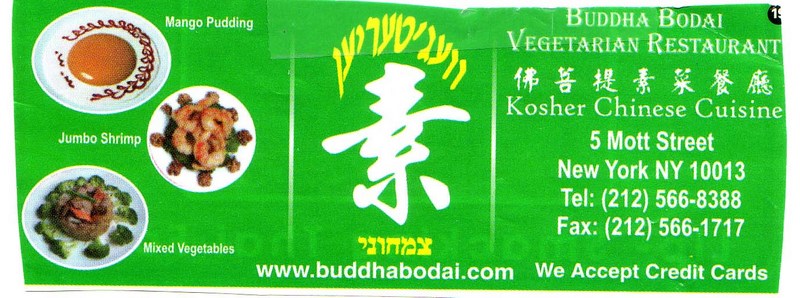 By the end of the 1990's, one vegetarian restaurant, BUDDHA BODAI VEGETARIAN RESTAURANT; 42-96 MAIN STREET; FLUSHING NY was a favorite source. They lost their lease, moved a few blocks south on Main Street, and then they became two when the chef opened a second BUDDHA BODAI; at 215 MOTT STREET; in AMNHATTAN; phone: (212) 566-8388. Both serve mango pudding. In Flushing, this dessert originally made its way only to special guests and to large parties. Now, it is on both their menus. It began as the chef's treat, testing the waters trying out things learned during his two year stint in a French restaurant. There he learned about acidified cream and squeezed fruit concentrates for decor. Now, his beautiful Mango Pudding has swirls of raspberry concentrate on a 'cream' made of soy milk. It sits bull's eye in the center of a plate, as pretty as a picture.
By the end of the 1990's, one vegetarian restaurant, BUDDHA BODAI VEGETARIAN RESTAURANT; 42-96 MAIN STREET; FLUSHING NY was a favorite source. They lost their lease, moved a few blocks south on Main Street, and then they became two when the chef opened a second BUDDHA BODAI; at 215 MOTT STREET; in AMNHATTAN; phone: (212) 566-8388. Both serve mango pudding. In Flushing, this dessert originally made its way only to special guests and to large parties. Now, it is on both their menus. It began as the chef's treat, testing the waters trying out things learned during his two year stint in a French restaurant. There he learned about acidified cream and squeezed fruit concentrates for decor. Now, his beautiful Mango Pudding has swirls of raspberry concentrate on a 'cream' made of soy milk. It sits bull's eye in the center of a plate, as pretty as a picture.
Recently, in Los Angeles, we had two very different variations, interesting, but not worth a photograph. One was a layer of softened mango ice cream as bed and basket for the pudding. The other buried the pudding under a huge pile of whipped low-fat cream.
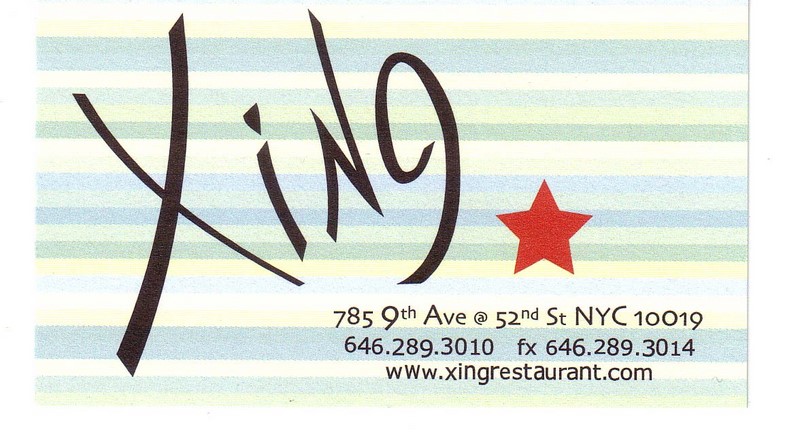 Move over all mango puddings. XING; 785 9th AVENUE; in mid-MANHATTAN; phone: (212) 289-3010. serves the most colorful of these puddings with the best texture and exotic looks. The maitre d' at this upscale place pushes it, trying to get folks to order it. We are glad we did.
Move over all mango puddings. XING; 785 9th AVENUE; in mid-MANHATTAN; phone: (212) 289-3010. serves the most colorful of these puddings with the best texture and exotic looks. The maitre d' at this upscale place pushes it, trying to get folks to order it. We are glad we did.
There is more to eat here, lots of interesting items on their contemporary menu. We recommend Braised Pork-belly Salad, Peking Duck Salad, Galangal & Scallion Crusted Black Cod, Wok Fried Morning Glory, and Pork Fried Rice. And then there is the fantastic Mango Pudding. 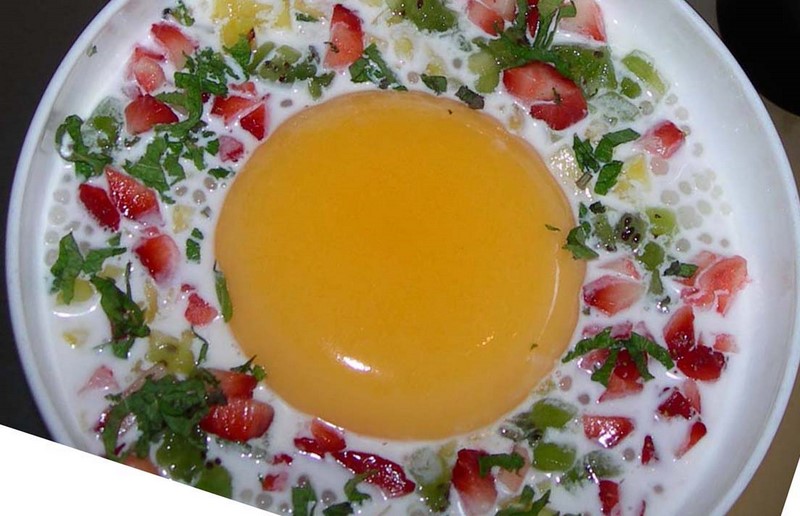 It comes with coconut tapioca and tempts as it did us. It comes surrounded by chopped strawberries, coriander, pineapple, kiwis, and more. It sits bull’s eye in the middle. Though we love it as is, we could adore it even more with pieces of mango in or around it.
It comes with coconut tapioca and tempts as it did us. It comes surrounded by chopped strawberries, coriander, pineapple, kiwis, and more. It sits bull’s eye in the middle. Though we love it as is, we could adore it even more with pieces of mango in or around it.
Appetizers at Xing run the gamut. Tea costs several bucks extra with no menu warning. There are several good varieties, all tea bags, to select from. The Mango Pudding, at seven bucks, wins my heart each and every time. We select it after an order of Sichuan Grilled Sirloin Steak or their Hanger Steak, made rare, as ordered.
PET PEEVES about Chinese food can politely be called: People say the strangest things. In the magazine Time Out New York, Patricia Yeo is quoted as saying: "At Chinese Banquets, rice is served last because it is highly prized." While parents do train their children to eat every grain of rice at regular meals, not eating much of it at a banquet is the polite thing to do. Why? Because eating all of this last item would tell the host/hostess you are still hungry and not enough food was provided. The same would be true in Northern China were the last banquet food item a noodle dish. Of course, these days, sweets can be the closing dish at banquets, more like western style meals. But, be that as it may, rice was never there because of status. It was there because, to some no meal is complete without it.
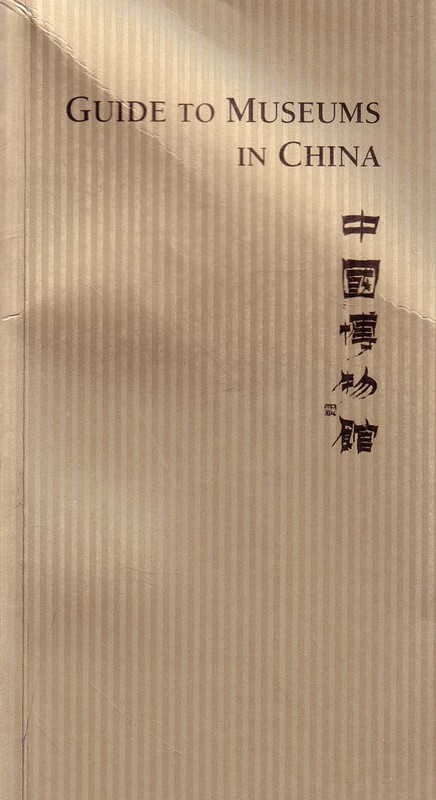 MUSEUMS in CHINA are growing in number and improving in content vis-a-vis lighting and signs advising what is on display. A few even have their signs in languages besides Chinese. For museum buffs, Joanna Capon in 2002, published a handy little volume, now out of print. With patience it can be found on the web. Called Guide to Museums in China, and published by Orientations Magazine Limited, it lists and discusses dozens and dozens of them. We were not sucessful, but you might get information about the two hundred forty-four page book from the author who can be reached at: Orientations, 17th floor, 200 Lockhart Road in Hong Kong. The book gives her e-mail as omag@netvigator.com; you can try that, too.
MUSEUMS in CHINA are growing in number and improving in content vis-a-vis lighting and signs advising what is on display. A few even have their signs in languages besides Chinese. For museum buffs, Joanna Capon in 2002, published a handy little volume, now out of print. With patience it can be found on the web. Called Guide to Museums in China, and published by Orientations Magazine Limited, it lists and discusses dozens and dozens of them. We were not sucessful, but you might get information about the two hundred forty-four page book from the author who can be reached at: Orientations, 17th floor, 200 Lockhart Road in Hong Kong. The book gives her e-mail as omag@netvigator.com; you can try that, too.
Historical archeologist and art historian, Capon travels extensively and discusses the contents of these places. She advises the first major public museum opened in Beijing in 1911 and is known as the Museum of Antiquities. She discusses it and others in this capital and many more in provincial capitals and cites that are not capitals.
Capon talks about the practice, prevalent in the 1970's, of using a display to promote a particular political idea, the current emphasis of space devoted to the incorporation of minority objects, and that museum libraries are rarely available to the public.
The book does give hours and days when a particular museum is open; but as she says, do not count on their being in effect, and do not count on phone and fax numbers as still in use. They seem to change. What the book does provide is knowledge of museums and where they are. Ask a hotel or travel agent in a particular city and get their help in contacting a particular one. Call before going and get any other information you might want or need.

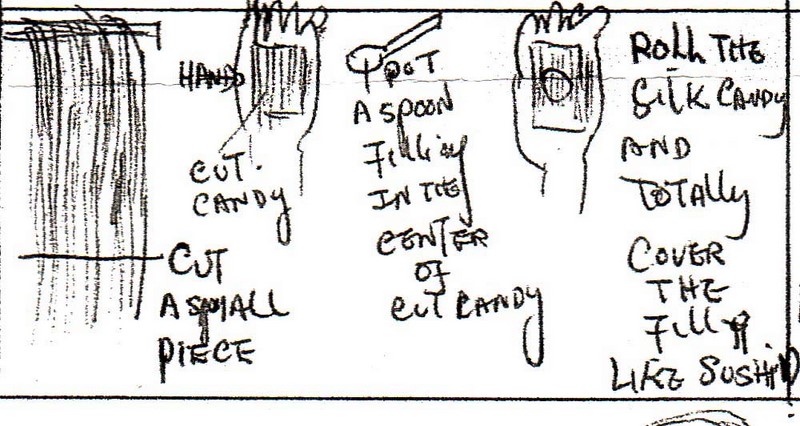 DRAGON BEARD CANDY is a favorite in many southern regions of China. It is made in the United States, contrary to what we reported in Volume 11(2) on page 8. Before the close of Joseph Poon’s restaurant in Philadelphia (reported by Harley Spiller in Volume 13(1) on pages 29, 30, and 31), we were honored to not only have some there, but also see Joseph Poon demonstrate how he makes it.
DRAGON BEARD CANDY is a favorite in many southern regions of China. It is made in the United States, contrary to what we reported in Volume 11(2) on page 8. Before the close of Joseph Poon’s restaurant in Philadelphia (reported by Harley Spiller in Volume 13(1) on pages 29, 30, and 31), we were honored to not only have some there, but also see Joseph Poon demonstrate how he makes it.
He was kind enough to share his recipe with us and make an illustration to do so; also to write out the Chinese caracters if you need them to ask other restauranterus about making it.
Before making any, Chef Poon advises about equipment needed including is a non-stick frying pan, a bowl for three cups of cold water, six-inch bamboo skewers and oiled plastic containers. He states that when pulling, do so evenly, then twist, then overlap. He says you need to pull, twist, and overlap fourteen times to get sixteen thousand two hundred and twenty-four strands of this silken candy. Keep in mind that patience and practice makes perfect! His recipe is at the bottom of this column.
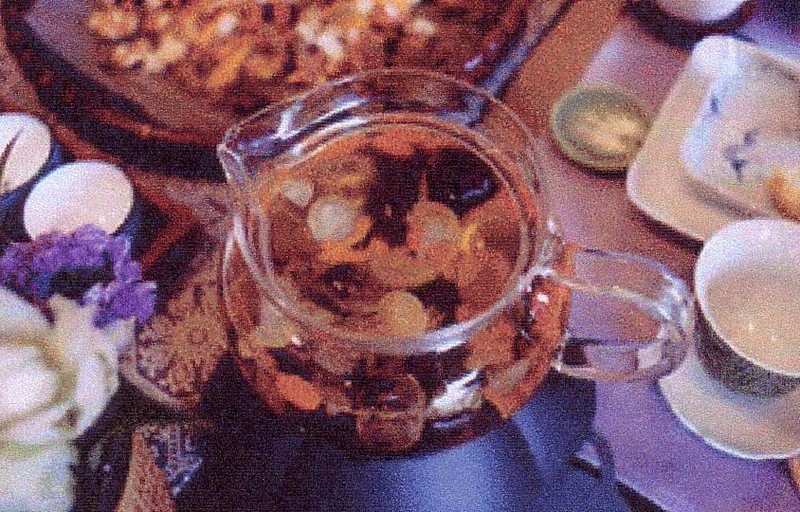 EIGHT TREASURE TEA was brought to our attention by by Sherry Foo Masser. Called ba bao cha, she shared a recipe for it which she claims is better than any packaged ones. We agree and thanks to her, share it here at the bottom of the column with you. Simply take a teapot and put in one teaspoon of loose green tea, three or four pieces of rock sugar, two Chinese red dates, one dried Chinese chrysanthemum blossom (optional), one dried apricot, one almond, three or four wolfberries (Lycium chinensis) or a like number of raisons, and one dried lychee or a dried longan.
EIGHT TREASURE TEA was brought to our attention by by Sherry Foo Masser. Called ba bao cha, she shared a recipe for it which she claims is better than any packaged ones. We agree and thanks to her, share it here at the bottom of the column with you. Simply take a teapot and put in one teaspoon of loose green tea, three or four pieces of rock sugar, two Chinese red dates, one dried Chinese chrysanthemum blossom (optional), one dried apricot, one almond, three or four wolfberries (Lycium chinensis) or a like number of raisons, and one dried lychee or a dried longan.
The original source places them in a gai wan, adds hot water to the eight items, and steeps them for about three minutes. They recommend sipping the liquid, and refilling the giawan with hot water up to five times until the flavor is gone. Her recipe comes from archives posted at www.teaswap.stefmike.org
BLACK GRASS JELLY, sometimes called 'wiggled Chinese jello-vine food,' is made from the fruit Ficus pumila var. awkeotsang. Actually, it is a variety of fig, sometimes eaten out of hand, but more commonly processed or cooked with a little sugar and made into a jelly. With even more water, it can be a beverage. It is common in China and throughout East Asia as both beverage and jelly. Many wonder if it is made with added coloring. The answer is no; it is naturally black. Commonly served at dim sum, the jelly can be purchased in cans. We have never seen the beverage in cans, have you?
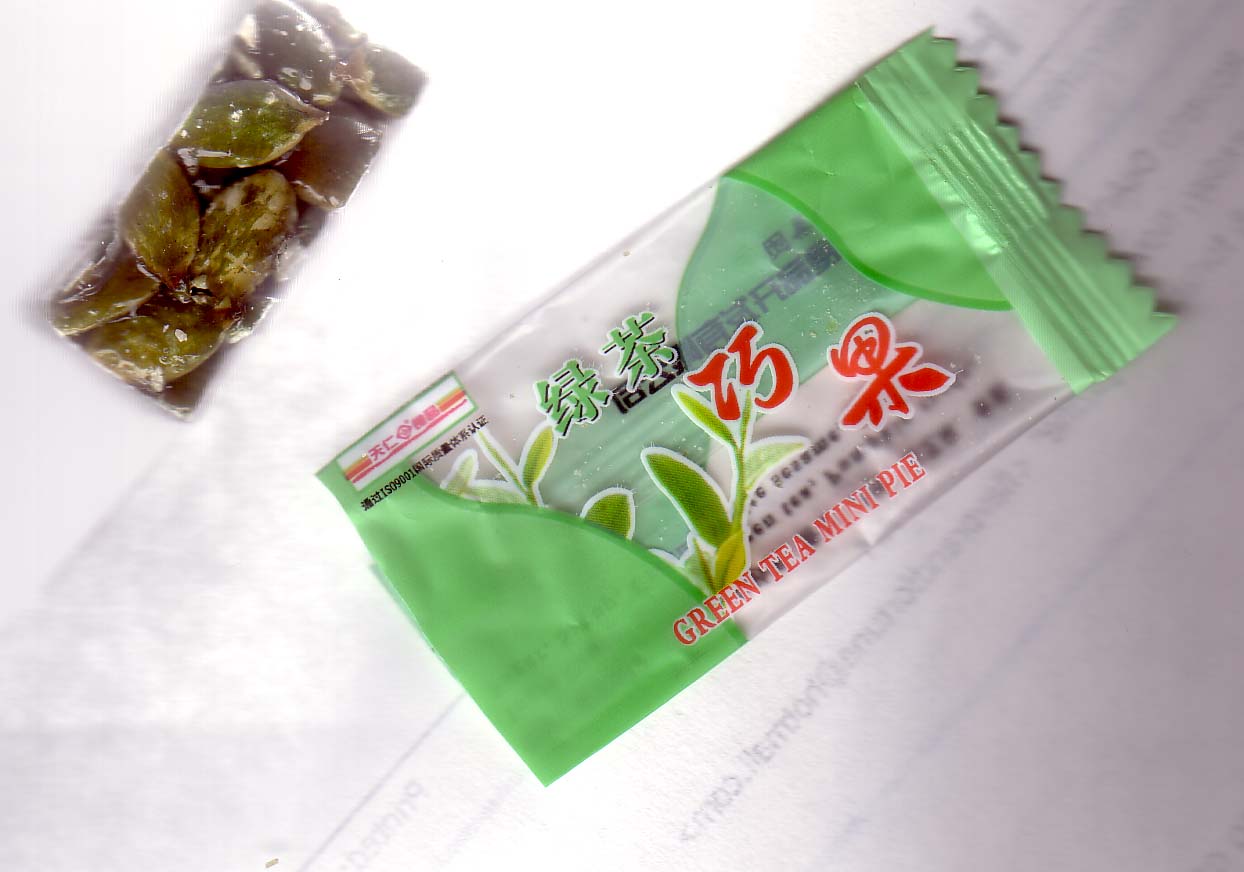 GREEN TEA CANDIES are popping up all over. Most are tasteless, bitter, and not worth the calories. The best ever are made by the Zhangzhou Tenfu Tea Industry Co. Ltd. in Zhangzhou in China's Fujian Province. Distributed by Ten Ren Tea and Ginseng Company, they call and sell these goodies under the name of 'Green Tea Min Pie.' Why we know not as they are no pie. But they are yummy nutty tea snacks. Made with steamed green tea, pumpkin seeds, sugar, syrup, cream, white sesame seeds, and salt, they are addictive. Often, we begin each day with some in purse or pocket, and every one is consumed, before dinner and before coming home. Not great at sharing, no matter how many we begin with, we consume them all solo.
GREEN TEA CANDIES are popping up all over. Most are tasteless, bitter, and not worth the calories. The best ever are made by the Zhangzhou Tenfu Tea Industry Co. Ltd. in Zhangzhou in China's Fujian Province. Distributed by Ten Ren Tea and Ginseng Company, they call and sell these goodies under the name of 'Green Tea Min Pie.' Why we know not as they are no pie. But they are yummy nutty tea snacks. Made with steamed green tea, pumpkin seeds, sugar, syrup, cream, white sesame seeds, and salt, they are addictive. Often, we begin each day with some in purse or pocket, and every one is consumed, before dinner and before coming home. Not great at sharing, no matter how many we begin with, we consume them all solo.
These tea snacks are made with steamed Japanese Sencha tea. Good thing there are lots of Ten Ren stores world-wide. In New York City, there are half dozen in many of the boroughs. We recently visited Los Angeles and San Francisco and stocked up there, too. To date we have visited all six in the Big Apple and do wish there were others on Long Island, where we live. For the nearest Ten Ren store, call 1-800-292-2049. That, or check the web at www.tenrenusa.com Should you get addicted, never let it be said we did not warn you!
ANGELA CHENG update is in answer to the many queries about this lady who is Fu Pei Mei's daughter and a cookbook author in her own right. Several of her cookbooks were reviewed in the last issue. See Volume 13(1) on pages 23 and 24, and others in other issues. Under the guidance of her mother, Angela learned many principles and techniques popular in Chinese cooking. She has become an expert chef, and to date, has thirty years of experience teaching Chinese cooking. She is a very popular cooking instructor in Taiwan and is an expert chef. She has done many television cooking program demonstrations and written more than fifty cookbooks including the smattering few reviewed in this magazine. Some are only in Chinese, a pity for those of us whose skills do not include this language. We have enjoyed and cooked from all reviewed in the pages of this magazine. As we locate others or some of the Chinese ones do get translated, we promise to share them with our readers.
| Joseph Poon's Dragon Beard Candy |
|---|
1 bottle corn syrup 1 Tablespoon maltose 2 pounds cornstarch 1 pound roasted chopped peanuts 1 pound toasted sesame seeds 4 ounces sugar 2 ounces very fine dry coconut Preparation: 1. Heat corn syrup, maltose, and two tablespoons of water in a non-stick frying pan for thirteen or fourteen minutes. 2. Using a bamboo skewer, pick up some cooking syrup, and at the same time, turn off the heat. Dip the cooking syrup into three cups cold water and stir it back and forth. 3. Pick up the cooked syrup in your fingers and check that it became softly solidified, not hard. 4. Use your finger to pinch it. Make sure it is not dripping nor hard, but somewhere in between these textures. 5. Pour into four oiled containers and let set about three to four hours and turn the plastic containers upside down. 6. Make a hole in the center using a chopstick and turn out the somewhat hardened doughnut-shaped mixture. Dip it into cornstarch. Then start pulling evenly and twisting, and overlap it. Twist and overlap fourteen times. Then cut a small section of these threads and fill. 7. To make the filling, mix the peanuts, sesame seeds, sugar, and coconut thoroughly. Take a spoon of this filling and put it in the center of the cut candy threads. Roll the silk threads to totally cover the filling, like sushi. Serve or store for a short time in more cornstarch. Repeat until all thread-like candy is filled, rolled, and dusted with cornstarch. Then serve. |

Copyright © 1994-2025 by ISACC, all rights reserved
Address
3 Jefferson Ferry Drive
S. Setauket NY 11720